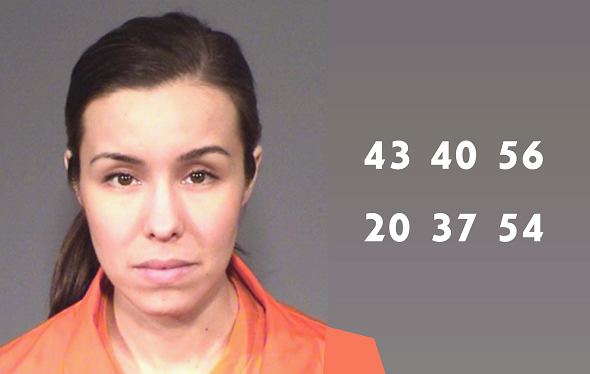The book cipher of the murderess Jodi Arias
From prison, Jodi Arias, a U.S. citizen accused of murder, attempted to send an encrypted message. With the help of my readers, I would like to know how the method she used worked.
“True crime” is booming – on TV, on the Internet and on the book market. True crime stories are also regularly well received on Cipherbrain. I won’t run out of material anytime soon, because there are many criminal cases in which encryption plays a role. These include, for example, the Zodiac Killer, whose second encrypted message was solved last year. Dave Oranchak, who was involved in the decryption, posted another video on the subject a few days ago. Among other things, it talks about how close others have come to deciphering the near-future. It’s absolutely worth watching.
Anyone interested in encryption and crime should definitely listen to my next ICCH talk on June 26, 2021 (I’ll be giving it again with Elonka Dunin). Here is the tentative agenda:
As always, dial-in details for this online lecture are available on the ICCH mailing list or from me upon request. There is no charge to attend.
The Travis Alexander muder case
Let us now turn to a coded message with a criminological connection that I was not aware of until recently. It plays a role in connection with the murder of the insurance agent Travis Alexander. The following information about this case can be found on Wikipedia:
On June 4, 2008, 30-year-old Travis Alexander was killed in his Mesa, Arizona, apartment with a gunshot to the head, 27 stab wounds, and a throat slash. The public interest was so great, among other things, because the trial of the main suspect Jodi Arias took place in front of running cameras and violence and pornography played central roles.
Jodi Arias became entangled in contradictions in court that made her appear increasingly untrustworthy. Thus, on May 8, 2013, she was found guilty of the murder (First Degree Murder) of her ex-boyfriend Travis Alexander, and on April 13, 2015, she was sentenced to life in prison without the possibility of parole.
The coded message
What can’t be read on Wikipedia, but is in an online article, is that Jodi Arias tried to smuggle an encrypted message out of prison to her friend Ann Campbell in August 2011, during the trial.
Arias used two magazines to transmit the messages: an issue of the Star and an issue of Digital Photo Pro. The two magazines were intercepted by guards before Arias managed to deliver them to her friend during a visit. The guards had noticed small notes written in pencil.
At the bottom of one page in the “Star” was the following series of numbers: 43 40 56 20 37 54. Each number, the prosecutor said, corresponded to a page number from “Digital Photo Pro” magazine. In total, according to the prosecutor’s office, the message was as follows:
You f***ed up what you told my attorney the next day
directly contradicts what I’ve been saying for over a year
get down here ASAP and see me before you talk to them again and before
you testify so
we can fix this
interview was excellent! Must talk ASAP!
The prosecution considered this message an attempt to influence the testimony of a witness. Presumably, Arias’ girlfriend was supposed to forward the message. It is not known who the actual recipient was supposed to be. One possibility would be Arias’ ex-boyfriend Matthew McCartney, who testified at trial. Arias denied trying to influence a witness, as you can see in the video below:
Whether Arias said anything else about the coded message is not known to me. As mentioned earlier, the trial ended with a “Life without Parole” sentence.
The encryption
The encryption method used by Arias is a so-called book cipher – even though a magazine was used here instead of a book. In a book cipher, a group of numbers or letters each refers to a letter or word in a book. For example, 12311 could stand for the eleventh word on page 123 of a book. The book to which the references are made is part of the key.
Book ciphers are covered in detail in my recent book, Codebreaking: A Practical Guide.
Unfortunately, it is not entirely clear to me exactly how the book cipher used by Arias worked. The message referred to in the article consists of six two-digit numbers (“43 40 56 20 37 54”), while the message consists of six lines. Presumably, each number refers to one line. However, it is hardly possible to encode such a long message with so little information.
I suspect, therefore, that the information in the article is not complete. It is possible that the six numbers stand for page numbers, on which the relevant letters are also marked.
Does any reader manage to find out more about this coded message. If so, please let me know in the comments section.
If you want to add a comment, you need to add it to the German version here.
Follow @KlausSchmeh
Further reading: Kinderporno-Verdächtiger begeht Selbstmord und hinterlässt verschlüsselte Festplatten
Linkedin: https://www.linkedin.com/groups/13501820
Facebook: https://www.facebook.com/groups/763282653806483/





Letzte Kommentare